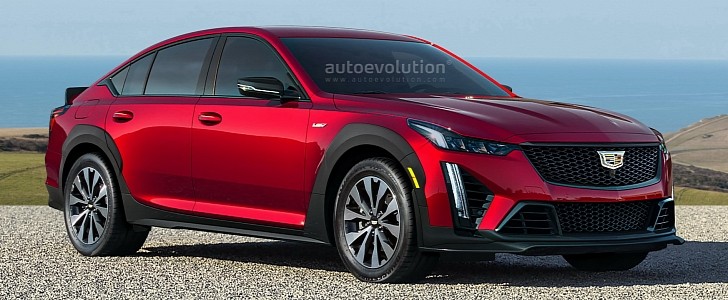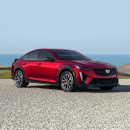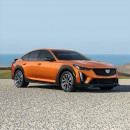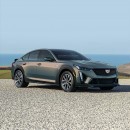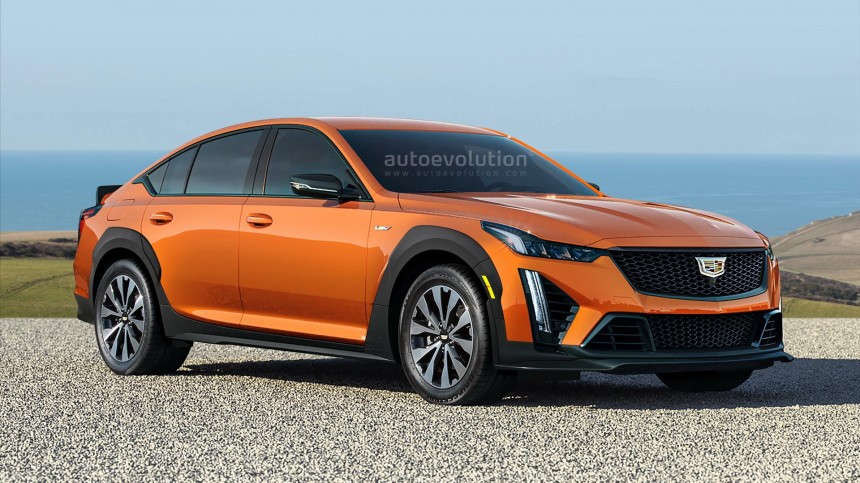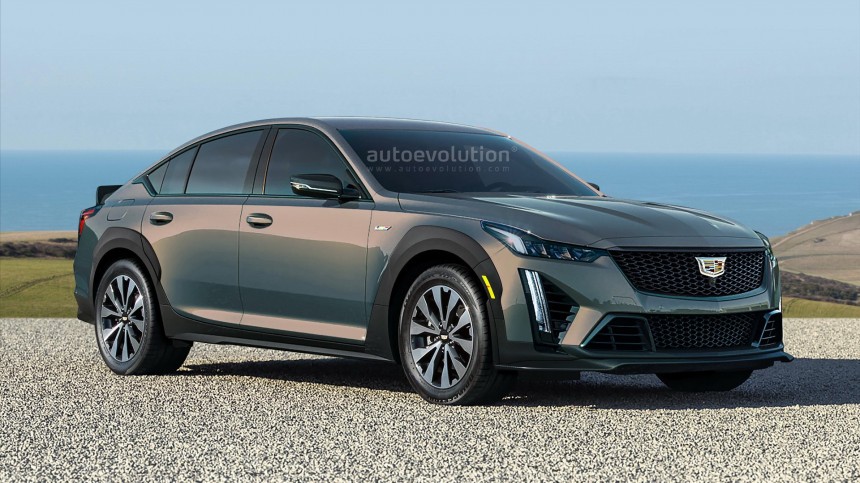Here’s a fun little thought experiment for you. A jacked-up version of the Cadillac CT5-V Blackwing, built specifically to give Porsche and their Taycan Cross Turismo a mild headache. Of course, it would have to be quite mild, seeing as how the Taycan is fully electric and the CT5-V Blackwing is one of those pesky internal combustion engine cars that hate the environment and subsequently, polar bears and baby seals.
Before we further contemplate this new and extremely hypothetical Cadillac model, let’s go back to where it all started for the carmaker, as far as these V-branded models are concerned.
It is the year 2004 and General Motors brainstormed their way into launching the first-ever CTS-V, which they believed would compete with the likes of the BMW M5 or the AMG-powered Mercedes-Benz E-Class. The original CTS-V came with a 5.7-liter V8 engine, producing 400 hp and 395 lb-ft (536 Nm) of torque – that's the same power unit found in the C5 Z06 Corvette, albeit with less power.
Later, the first-gen CTS-V would get a new 6.0-liter V8 engine, with the same power and torque figures as the last one, but a wider torque band.
The second-gen CTS-V was even better, and a much more dangerous opponent for its German rivals. It was unveiled in 2009, powered by a 6.2-liter LSA V8 engine, much like the one from the C6 Corvette ZR1. It had 556 hp and 551 lb-ft (747 Nm) of torque, which was enough to get you to 60 mph (97 kph) in under four seconds flat.
Then came the third-generation CTS-V, with its 640 hp and 630 lb-ft (854 Nm) of torque. Some people referred to this as the four-door Corvette, because it had the same engine as the C7 Corvette Z06, with just 10 less horsepower. Thanks to a modern eight-speed automatic gearbox, this iteration of the CTS-V could rocket to 60 mph in just 3.5 seconds, which is impressive regardless of your grading curve.
Finally, we arrive at the CT5, which replaced the CTS in 2019, resulting in the CT5-V and CT5-V Blackwing taking over for the CTS-V. Now, while the CT5-V does serve a purpose, it’s no match for any flagship German super sedans. Its 3.0-liter twin-turbo V6 engine only produces 360 hp and 405 lb-ft (549 Nm) of torque, so if you want real muscle, you’ll need the Blackwing variant, with its supercharged 6.2-liter V8, putting down 668 hp and 659 lb-ft (893 Nm) of torque.
This is one seriously quick Caddy, needing no more than 3.4 seconds in order to hit 60 mph from a standstill. It’s not considerably faster than the old CTS-V, but it will blow your mind, nonetheless.
But what if Cadillac had done something completely different with the CT5-V Blackwing? I’m talking about the addition of a Cross Turismo-like variant, just as quick as the regular model, but with more ground clearance so that you don’t feel completely horrible about taking off the beaten path.
Such a vehicle might persuade an individual or two from buying something like the Porsche Taycan Cross Turismo, but since the latter is fully electric and the CT5-V isn’t, well, it’s more of an apples and oranges type of situation.
Still, the CT5-V Blackwing clearly looks handsome in “Cross Turismo” guise, as demonstrated by this exclusive rendering courtesy of Joao Kleber Amaral. If you live somewhere with a lot of gravel roads, or maybe even some dirt roads, you’d probably be more likely to purchase this type of CT5-V Blackwing variant, rather than the regular one.
It’s fascinating how body cladding can help certain cars look better. It’s probably because it adds heft, which results in a more “substantial” product, offering its owner improved road presence.
It is the year 2004 and General Motors brainstormed their way into launching the first-ever CTS-V, which they believed would compete with the likes of the BMW M5 or the AMG-powered Mercedes-Benz E-Class. The original CTS-V came with a 5.7-liter V8 engine, producing 400 hp and 395 lb-ft (536 Nm) of torque – that's the same power unit found in the C5 Z06 Corvette, albeit with less power.
Later, the first-gen CTS-V would get a new 6.0-liter V8 engine, with the same power and torque figures as the last one, but a wider torque band.
The second-gen CTS-V was even better, and a much more dangerous opponent for its German rivals. It was unveiled in 2009, powered by a 6.2-liter LSA V8 engine, much like the one from the C6 Corvette ZR1. It had 556 hp and 551 lb-ft (747 Nm) of torque, which was enough to get you to 60 mph (97 kph) in under four seconds flat.
Then came the third-generation CTS-V, with its 640 hp and 630 lb-ft (854 Nm) of torque. Some people referred to this as the four-door Corvette, because it had the same engine as the C7 Corvette Z06, with just 10 less horsepower. Thanks to a modern eight-speed automatic gearbox, this iteration of the CTS-V could rocket to 60 mph in just 3.5 seconds, which is impressive regardless of your grading curve.
This is one seriously quick Caddy, needing no more than 3.4 seconds in order to hit 60 mph from a standstill. It’s not considerably faster than the old CTS-V, but it will blow your mind, nonetheless.
But what if Cadillac had done something completely different with the CT5-V Blackwing? I’m talking about the addition of a Cross Turismo-like variant, just as quick as the regular model, but with more ground clearance so that you don’t feel completely horrible about taking off the beaten path.
Still, the CT5-V Blackwing clearly looks handsome in “Cross Turismo” guise, as demonstrated by this exclusive rendering courtesy of Joao Kleber Amaral. If you live somewhere with a lot of gravel roads, or maybe even some dirt roads, you’d probably be more likely to purchase this type of CT5-V Blackwing variant, rather than the regular one.
It’s fascinating how body cladding can help certain cars look better. It’s probably because it adds heft, which results in a more “substantial” product, offering its owner improved road presence.
